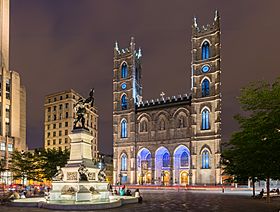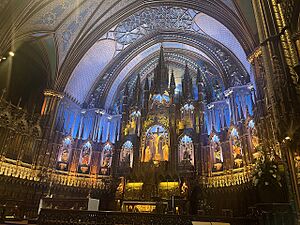Notre-Dame Basilica (Montreal) facts for kids
Quick facts for kids Notre-Dame BasilicaBasilique Notre-Dame de Montréal |
|
|---|---|

The church building's exterior, 2017
|
|
| 45°30′16″N 73°33′22″W / 45.50444°N 73.55611°W | |
| Location | 110 Notre-Dame Street West Montreal, Quebec, Canada H2Y 1T2 |
| Denomination | Roman Catholic |
| History | |
| Status | Minor basilica |
| Dedication | Mary |
| Dedicated | July 1, 1829 |
| Architecture | |
| Functional status | Active |
| Architect(s) | James O'Donnell, Victor Bourgeau (interior) |
| Style | Gothic Revival, English Gothic |
| Groundbreaking | 1823 |
| Completed | 1865 (facade) |
| Construction cost | £47,446 (1832) |
| Specifications | |
| Length | 79 metres (259 ft) |
| Width | 46 metres (151 ft) |
| Height | 60 metres (200 ft) |
| Materials | Stone, which came from the Tanneries quarry in Griffintown |
| Administration | |
| Archdiocese | Montreal |
The Notre-Dame Basilica of Montreal (in French: Basilique Notre-Dame de Montréal) is a beautiful Catholic church in the old part of Montreal, Quebec, Canada. It is located at 110 Notre-Dame Street West, right next to the Saint-Sulpice Seminary. It also faces a public square called Place d'Armes.
The inside of the church is truly amazing and is known as a masterpiece of Gothic Revival style. The ceilings are a deep blue with golden stars, and the rest of the church is decorated with many colors like blue, red, purple, silver, and gold. You can see hundreds of detailed wooden carvings and many religious statues. Unlike most churches, the stained glass windows here do not show scenes from the Bible. Instead, they tell stories from Montreal's religious history. The basilica also has a huge pipe organ from 1891 with 7,000 pipes!
About 11 million people visit Notre-Dame Basilica every year. This makes it one of the most visited landmarks in North America. In 2023, it was even named the 6th most beautiful building in the world by a publication called Angi.
Contents
History of the Basilica
Building a New Church
In 1657, a group of Catholic priests called the Sulpicians arrived in Montreal. They started a church parish dedicated to Mary. The first Notre-Dame church was built on this spot in 1672. Over time, the church became too small for the growing number of people.
By 1824, the community needed a much bigger church. An architect named James O'Donnell was hired to design the new building. He was an Irish-American who loved the Gothic Revival style. He designed the church to hold up to 10,000 people! O'Donnell is the only person buried in the church's crypt. He became Catholic just before he died, which allowed him to be buried there.
Construction and Design
The main construction of the new church happened between 1824 and 1829. The first stone was laid on September 1, 1824. The main part of the church was finished in 1830. The first tower was completed in 1841, and the second in 1843. O'Donnell designed the towers to be very tall and visible from anywhere in the city. After O'Donnell passed away, another architect, John Ostell, finished the towers. When it was completed, the church was the largest in North America for over 50 years.
The front of the church was finished in 1865. It includes three statues by a French artist named Henri Bouriché. These statues are of Saint Joseph, the Virgin Mary, and Saint Jean-Baptiste.
The inside of the church took much longer to decorate. Victor Bourgeau worked on it from 1872 to 1879. He was inspired by the Sainte-Chapelle in Paris. He used gold leaf designs and brightly painted columns to create the stunning interior you see today.
The Sacred Heart Chapel
Because the main church was so grand, a smaller, more private chapel was built behind it. This was the Chapelle du Sacré-Cœur, or Chapel of the Sacred Heart. It was finished in 1888. In 1886, a company called Casavant Frères started building a new, large pipe organ for the church. It was completed in 1891 and was special because it was the first organ with electric controls for some of its parts.
Sadly, the Sacré-Cœur Chapel was destroyed by a fire in 1978. It was rebuilt with its first two levels looking like the original. The new chapel also has modern ceilings and a huge bronze artwork by Quebec artist Charles Daudelin.
Important Recognitions
On April 21, 1982, Pope John Paul II gave Notre-Dame Church the special title of a "minor basilica." This is a high honor for a church. In 1989, the Notre-Dame Roman Catholic Church was also named a National Historic Site of Canada.
Notable Events at the Basilica
The Notre-Dame Basilica has been the site of many important events:
- On May 31, 2000, the state funeral for famous hockey player Maurice "Rocket" Richard was held there. Thousands of people attended.
- On October 3, 2000, the state funeral for Pierre Trudeau, Canada's 15th prime minister, took place. His son, Justin Trudeau, who later became prime minister, gave a speech.
- The famous singer Celine Dion was married there on December 17, 1994. Her funeral service for her husband, René Angélil, was also held there on January 22, 2016.
- In the summer of 2014, a French collector showed off many items that belonged to Napoleon Bonaparte in the church's crypt.
- In April 2019, after a fire damaged Notre-Dame de Paris in France, Montreal's Notre-Dame Basilica announced it would accept donations to help rebuild the Paris cathedral.
- On March 23, 2024, the state funeral for Brian Mulroney, Canada's 18th prime minister, was held at the Basilica.
The Bells of Notre-Dame
Both of the basilica's towers have bells. The West Tower, called La Persévérance, has a very large bell named Jean-Baptiste. It was made in 1848 and weighs 10,900 kilograms (about 24,000 pounds)! Jean-Baptiste only rings on special occasions like funerals, big church holidays, and Christmas Eve. The East Tower, called La Temperance, has a set of ten bells that were made in 1842.
Visiting the Basilica
The basilica offers musical performances, including choir and organ concerts. Many Montrealers have a tradition of attending the annual performance of Handel's Messiah every Christmas.
More than 11 million people visit Notre-Dame Basilica each year. It is a very popular place to see in Montreal.
Organists of the Basilica
Many talented musicians have served as organists at the Notre-Dame Basilica over the years. Some of the notable organists include Jean-Baptiste Labelle, Alcibiade Béique, and Pierre Grandmaison, who has been the organist since 1973.
See also
 In Spanish: Basílica Notre-Dame de Montreal para niños
In Spanish: Basílica Notre-Dame de Montreal para niños
- Adam Charles Gustave Desmazures
- List of tallest structures built before the 20th century




